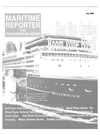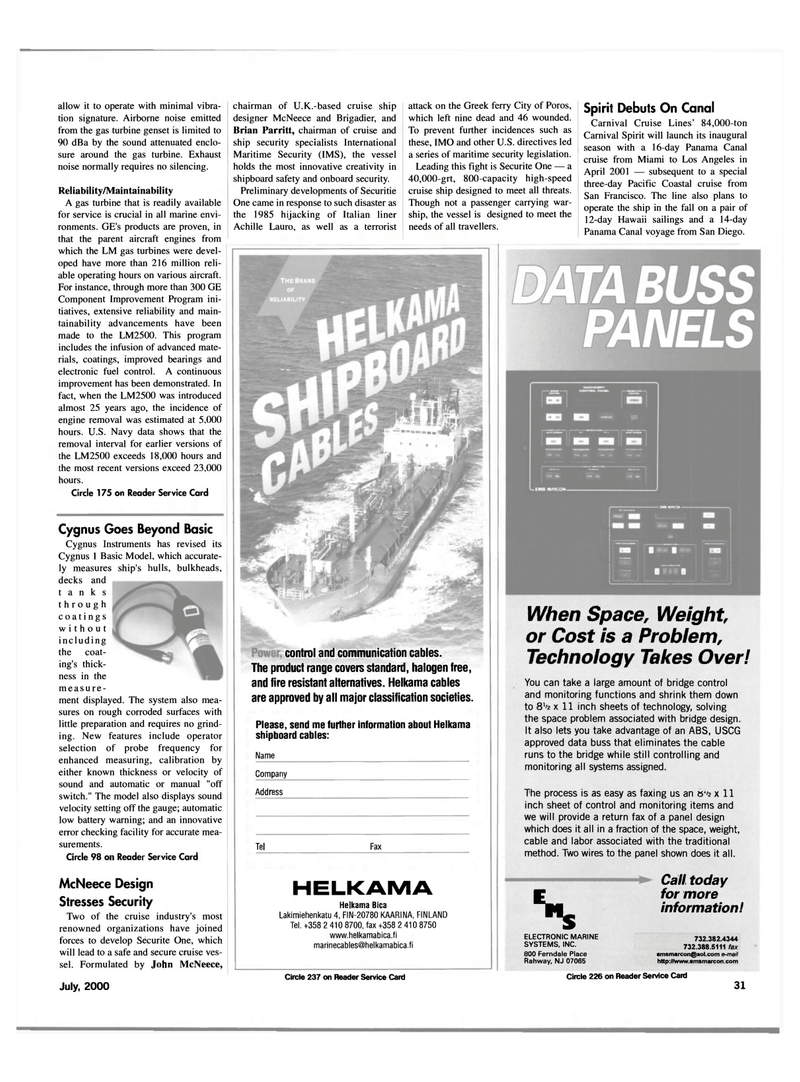
Page 31: of Maritime Reporter Magazine (July 2000)
Read this page in Pdf, Flash or Html5 edition of July 2000 Maritime Reporter Magazine
allow it to operate with minimal vibra- tion signature. Airborne noise emitted from the gas turbine genset is limited to 90 dBa by the sound attenuated enclo- sure around the gas turbine. Exhaust noise normally requires no silencing.
Reliability/Maintainability
A gas turbine that is readily available for service is crucial in all marine envi- ronments. GE's products are proven, in that the parent aircraft engines from which the LM gas turbines were devel- oped have more than 216 million reli- able operating hours on various aircraft.
For instance, through more than 300 GE
Component Improvement Program ini- tiatives, extensive reliability and main- tainability advancements have been made to the LM2500. This program includes the infusion of advanced mate- rials, coatings, improved bearings and electronic fuel control. A continuous improvement has been demonstrated. In fact, when the LM2500 was introduced almost 25 years ago, the incidence of engine removal was estimated at 5,000 hours. U.S. Navy data shows that the removal interval for earlier versions of the LM2500 exceeds 18,000 hours and the most recent versions exceed 23,000 hours.
Circle 175 on Reader Service Card
Cygnus Goes Beyond Basic
Cygnus Instruments has revised its
Cygnus 1 Basic Model, which accurate- ly measures ship's hulls, bulkheads, decks and tanks through coatings without including the coat- ing's thick- ness in the measure- ment displayed. The system also mea- sures on rough corroded surfaces with little preparation and requires no grind- ing. New features include operator selection of probe frequency for enhanced measuring, calibration by either known thickness or velocity of sound and automatic or manual "off switch." The model also displays sound velocity setting off the gauge; automatic low battery warning; and an innovative error checking facility for accurate mea- surements.
Circle 98 on Reader Service Card
McNeece Design
Stresses Security
Two of the cruise industry's most renowned organizations have joined forces to develop Securite One, which will lead to a safe and secure cruise ves- sel. Formulated by John McNeece,
July, 2000 chairman of U.K.-based cruise ship designer McNeece and Brigadier, and
Brian Parritt, chairman of cruise and ship security specialists International
Maritime Security (IMS), the vessel holds the most innovative creativity in shipboard safety and onboard security.
Preliminary developments of Securitie
One came in response to such disaster as the 1985 hijacking of Italian liner
Achille Lauro, as well as a terrorist attack on the Greek ferry City of Poros, which left nine dead and 46 wounded.
To prevent further incidences such as these, IMO and other U.S. directives led a series of maritime security legislation.
Leading this fight is Securite One — a 40,000-grt, 800-capacity high-speed cruise ship designed to meet all threats.
Though not a passenger carrying war- ship, the vessel is designed to meet the needs of all travellers.
Spirit Debuts On Canal
Carnival Cruise Lines' 84,000-ton
Carnival Spirit will launch its inaugural season with a 16-day Panama Canal cruise from Miami to Los Angeles in
April 2001 — subsequent to a special three-day Pacific Coastal cruise from
San Francisco. The line also plans to operate the ship in the fall on a pair of 12-day Hawaii sailings and a 14-day
Panama Canal voyage from San Diego. control and communication cables.
The product range covers standard, halogen free, and fire resistant alternatives. Helkama cables are approved by all major classification societies.
Please, send me further information about Helkama shipboard cables:
Name
Company
Address
Tel Fax
HELKAMA
Helkama Bica
Lakimiehenkatu 4, FIN-20780 KAARINA, FINLAND
Tel. +358 2 410 8700, fax +358 2 410 8750 www.helkamabica.fi [email protected]
Circle 237 on Reader Service Card
When Space, Weight: or Cost is a Problem,
Technology Takes Over!
You can take a large amount of bridge control and monitoring functions and shrink them down to 81* x 11 inch sheets of technology, solving the space problem associated with bridge design.
It also lets you take advantage of an ABS, USCG approved data buss that eliminates the cable runs to the bridge while still controlling and monitoring all systems assigned.
The process is as easy as faxing us an x 11 inch sheet of control and monitoring items and we will provide a return fax of a panel design which does it all in a fraction of the space, weight, cable and labor associated with the traditional method. Two wires to the panel shown does it all.
H
ELECTRONIC MARINE
SYSTEMS, INC. 800 Ferndaie Place
Rahway, NJ 07065
Call today for more information! 732.382.4344 732.388.5111 fax [email protected] e-mail http://www.emsmarcon.com
Circle 226 on Reader Service Card 31

 30
30

 32
32
